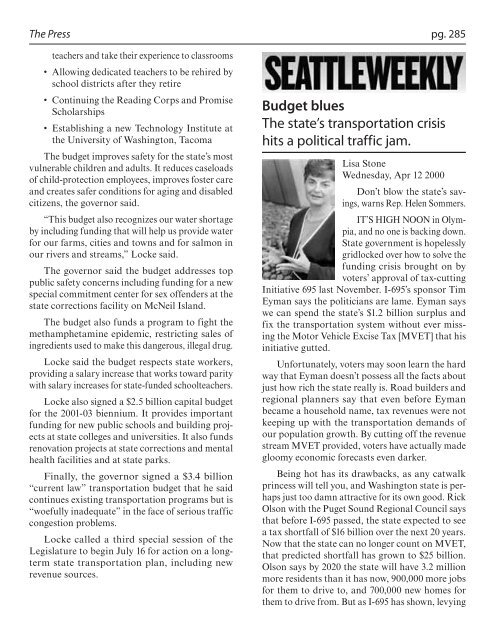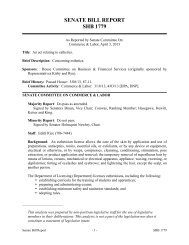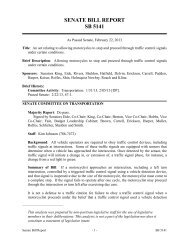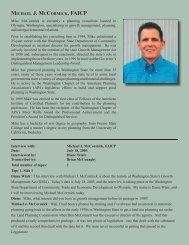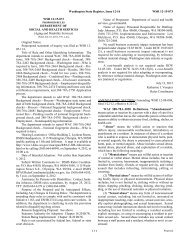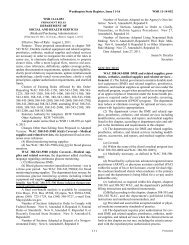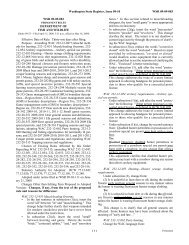Helen Sommers: An Oral History
Helen Sommers: An Oral History
Helen Sommers: An Oral History
Create successful ePaper yourself
Turn your PDF publications into a flip-book with our unique Google optimized e-Paper software.
The Press<br />
teachers and take their experience to classrooms<br />
• Allowing dedicated teachers to be rehired by<br />
school districts after they retire<br />
• Continuing the Reading Corps and Promise<br />
Scholarships<br />
• Establishing a new Technology Institute at<br />
the University of Washington, Tacoma<br />
The budget improves safety for the state’s most<br />
vulnerable children and adults. It reduces caseloads<br />
of child-protection employees, improves foster care<br />
and creates safer conditions for aging and disabled<br />
citizens, the governor said.<br />
“This budget also recognizes our water shortage<br />
by including funding that will help us provide water<br />
for our farms, cities and towns and for salmon in<br />
our rivers and streams,” Locke said.<br />
The governor said the budget addresses top<br />
public safety concerns including funding for a new<br />
special commitment center for sex offenders at the<br />
state corrections facility on McNeil Island.<br />
The budget also funds a program to fight the<br />
methamphetamine epidemic, restricting sales of<br />
ingredients used to make this dangerous, illegal drug.<br />
Locke said the budget respects state workers,<br />
providing a salary increase that works toward parity<br />
with salary increases for state-funded schoolteachers.<br />
Locke also signed a $2.5 billion capital budget<br />
for the 2001-03 biennium. It provides important<br />
funding for new public schools and building projects<br />
at state colleges and universities. It also funds<br />
renovation projects at state corrections and mental<br />
health facilities and at state parks.<br />
Finally, the governor signed a $3.4 billion<br />
“current law” transportation budget that he said<br />
continues existing transportation programs but is<br />
“woefully inadequate” in the face of serious traffic<br />
congestion problems.<br />
Locke called a third special session of the<br />
Legislature to begin July 16 for action on a longterm<br />
state transportation plan, including new<br />
revenue sources.<br />
Budget blues<br />
The state’s transportation crisis<br />
hits a political traffic jam.<br />
Lisa Stone<br />
Wednesday, Apr 12 2000<br />
pg. 285<br />
Don’t blow the state’s savings,<br />
warns Rep. <strong>Helen</strong> <strong>Sommers</strong>.<br />
IT’S HIGH NOON in Olympia,<br />
and no one is backing down.<br />
State government is hopelessly<br />
gridlocked over how to solve the<br />
funding crisis brought on by<br />
voters’ approval of tax-cutting<br />
Initiative 695 last November. I-695’s sponsor Tim<br />
Eyman says the politicians are lame. Eyman says<br />
we can spend the state’s $1.2 billion surplus and<br />
fix the transportation system without ever missing<br />
the Motor Vehicle Excise Tax [MVET] that his<br />
initiative gutted.<br />
Unfortunately, voters may soon learn the hard<br />
way that Eyman doesn’t possess all the facts about<br />
just how rich the state really is. Road builders and<br />
regional planners say that even before Eyman<br />
became a household name, tax revenues were not<br />
keeping up with the transportation demands of<br />
our population growth. By cutting off the revenue<br />
stream MVET provided, voters have actually made<br />
gloomy economic forecasts even darker.<br />
Being hot has its drawbacks, as any catwalk<br />
princess will tell you, and Washington state is perhaps<br />
just too damn attractive for its own good. Rick<br />
Olson with the Puget Sound Regional Council says<br />
that before I-695 passed, the state expected to see<br />
a tax shortfall of $16 billion over the next 20 years.<br />
Now that the state can no longer count on MVET,<br />
that predicted shortfall has grown to $25 billion.<br />
Olson says by 2020 the state will have 3.2 million<br />
more residents than it has now, 900,000 more jobs<br />
for them to drive to, and 700,000 new homes for<br />
them to drive from. But as I-695 has shown, levying


